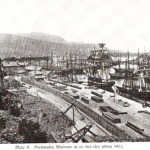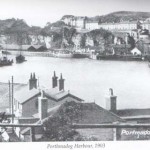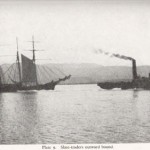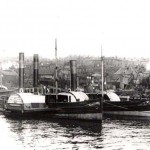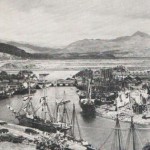…..That helped roof the world in the 19th Century
We are grateful to Philip Work for this interesting story
Tucked away in the North East corner of Cardigan Bay lies the small harbour of Porthmadog (Portmadoc), which was one of three major Slate exporting ports in North Wales during the 19th century.
Slate from the mines and quarries in the town of Blaenau Ffestiniog had originally been brought down to the river estuaries nearby on pack horses, however as the demand for good quality roofing slate grew in the early 1800’s, this method of transportation became inadequate.
In 1812 a causeway was built over the River Glaslyn estuary, and resulted in the hinterlands being reclaimed for farming, and new settlements established, the major one being the town of Porthmadog, and a harbour developed.
In 1836 a narrow gauge railway was opened connecting the slate town of Blaenau Ffestiniog and Portmadoc, and hence a means of transportation for the then ever expanding slate industry. Slate now reached the developing port of Portmadoc, where small sailing ships took slate around the ports of Great Britain and nearby Europe, Africa , North and South America.
Assistance getting out and into the harbour was required, as there are hazardous sand banks and rock reefs running out in a north east /south west angle across Cardigan Bay.
The expansion of the slate industry resulted in the demand for towing assistance for the small sailing ships into and out of Porthmadog; and a small tug company was founded. The Porthmadog Steam Tug Co. Ltd.
The first steam tug was built 1860 at North Shields by Hepple & Landells. ON 28619. Wood hull paddle tug “Wave of Life” (1). One 35hp side lever steam engine. Her first owners where in Liverpool. However she was sold to the Porthmadog Steam Tug Co.Ltd in October 1862 and registered at Caernafron. This tug held a Board of Trade summer passenger Certificates to ply between Aberystwyth and Bardsey Island from 1863 to 1868. She was sold again in 1872, to William Hepple of Newcastle upon Tyne, and re-registered at the Port of Newcastle 7.8.1872.
The second steam tug was built 1864 at Willington Quay for T.A Dry & M.P. Martin of Willington Quay, and W.G Dry of Gateshead and named “James Conley”. O.N. 49743. Wood hull paddle tug. One 30nhp side lever engine (cylinder 30″ diameter) 72 gross tons. Dimensions 81.8 x 17.1 x 9.1 ft. In 1866 she was sold to TSavin of Oswestry,(a railway construction contractor) and registered at the Port of Aberystwyth in 1866.
In 1871 she was resold to the Porthmadog Steam Tug Co.Ltd, and re-registered at the Port of Caernarfon, and continued to work for this company until 1884, when she was re-sold to S.Young of North Shields and re-registered at the Port of North Shields. She was sold a further two times, and was broken up in 1890.
The third steam tug was built in 1885 by Lawson & EItringham, South Shields. Iron hull 106g/tons. Two cylinder side lever engine 27″x 48″- 200nhp. By Baird & Barnsley Co. North Shields. Dimensions 96.0 x 18.7 x 9.4 ft. ON 80242. Named “Snowdon”. Registered at the Port of Caernarfon. and worked for the Porthmadog Steam Tug Co to 1900. She was sold to John Dry, South Shields, re-registered South Shields,
1900, and transferred to Redhead & Dry Tugs in 1929. Purchased by R.LCook Towage Co.Ltd of Sunderland in 1938 re – reg. Sunderland, and transferred to France, Fenwick Tyne & Wear Co.Ltd November 1947, and finally broken up after a varied career in 1950.
The fourth and last steam tug was the “Wave of Life 2” built by Hepple, Newcastle. Iron hull 102g/tons. Two side lever engines 50hp 26.5″ x 45″ stroke. Dimensions 91.2 x 17.9 x 9.2 ft. in 1872. for the Porthmadog Steam Tug Co. registered at the Port of Caernarfon. She continued to work until 1914, when the slate exporting trade had slumped, and was never to recover. She was sold to a Liverpool firm, and her hull was converted into a canal barge. The remains of which were broken up in 1935.
These tugs evidently were delivered by sailing from the Tyne north to Inverness, through the Caledonian Canal to Fort William, then south to their Welsh destination, and likewise a reverse sailing if they returned to the Tyne. This would make fascinating reading if any logs of their voyages had been made. Hope you enjoy these brief notes on the story of four small Tyne built tugs owned by the Portmadoc Steam Tug Co. between 1862 to 1914.
The development of the standard gauge railways in the North Wales area at the same time resulted in the demise of the need to transport slate via the sea… also at the end of the 1890s the demand for slate had declined. Finally the development of the steam ship resulted in there being no need for tug assistance in and out of the harbour.
Philip Work. Treasurer Tyne Area Shipping Club.
